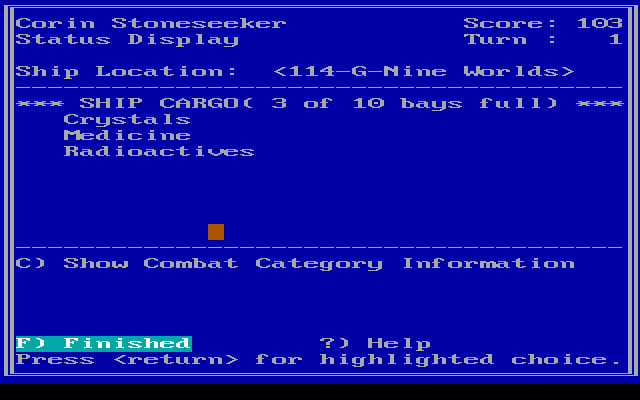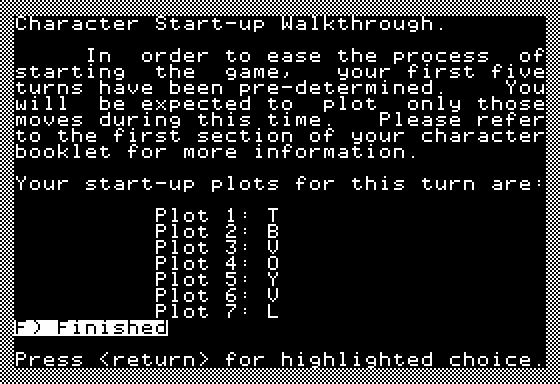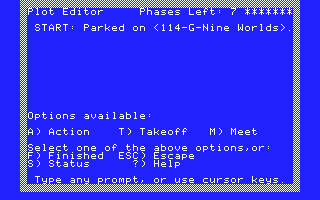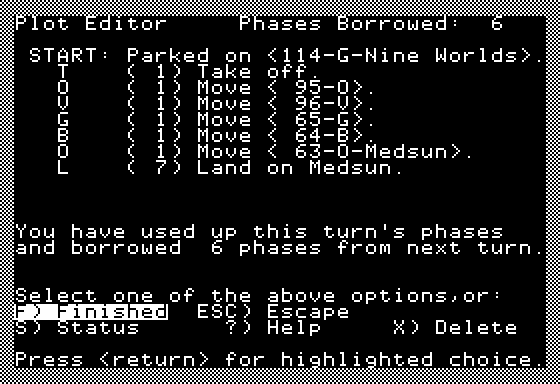Retro Replay Review
Gameplay
Star Saga: One – Beyond the Boundary stakes its claim as “Interactive Literature,” blending the freedom of pen & paper RPGs with the mechanical precision of computer-driven bookkeeping. Players gather around a single PC, each assuming control of one unique character drawn from the game’s presets. Unlike traditional computer RPGs where the party moves as a cohesive unit, here every adventurer operates independently, pursuing personalized missions that can intersect, cooperate, or even clash as the story unfolds.
(HEY YOU!! We hope you enjoy! We try not to run ads. So basically, this is a very expensive hobby running this site. Please consider joining us for updates, forums, and more. Network w/ us to make some cash or friends while retro gaming, and you can win some free retro games for posting. Okay, carry on 👍)
The gameplay loop revolves around map-based movement and text‐driven encounters. Each player moves a physical token on a fold-out map, then inputs that move into the software. The program handles stat adjustments, inventory changes, and the outcomes of skirmishes or diplomatic encounters—effectively removing the tedium of manual record‐keeping. When a new event triggers, the software directs you to one of the dozen narrative booklets, delivering richly written passages that advance the story and present consequential choices.
Combat pacing and exploration cadence are carefully balanced. Battles against alien foes or rival players resolve swiftly through automated calculations, so downtime is minimal. Exploration segments reward curiosity, unveiling secret locations, hidden relics, or special missions. Trading sequences with NPC factions or other players add a layer of strategy, as you barter for crucial items that can tip the scales in later conflicts. Each decision nudges the overarching narrative in different directions, encouraging multiple playthroughs to unlock all the branching paths.
Graphics
Given its 1988 release, Star Saga: One doesn’t rely on flashy visuals or real-time 3D. Instead, it features clean, functional interface screens that display your character’s stats, inventory lists, and movement options. The utilitarian graphics serve their purpose well, ensuring that inputs are clear and that the focus remains on the storytelling rather than on pixel-polish.
The real visual highlights arrive offline, in the form of two expansive fold-out maps and a set of tokens. These physical components evoke the tactile charm of a tabletop RPG, reinforcing the game’s hybrid identity. The maps are color-coded, clearly marking key star systems, trade routes, and hidden waypoints. Tokens bear simple but evocative illustrations that represent each character’s ship or avatar. Even today, unfolding these maps feels like opening a treasure chest full of possibilities.
While there are no animated cutscenes or sprite-based cinematics, the narrative booklets contain occasional black-and-white illustrations that capture pivotal moments—an alien confrontation, a starship wreck, a cryptic artifact. These sketches, sparse though they may be, offer visual fuel for your imagination, encouraging you to mentally fill in the gaps and become fully immersed in the world of Star Saga.
Story
Star Saga: One launches you into a sprawling sci-fi universe filled with political intrigue, ancient mysteries, and interstellar commerce. Each character’s journey is distinct, offering missions ranging from covert intelligence gathering to archaeological excavations on forsaken planets. Although the game only sees you handling one persona at a time, the story threads intertwine, creating a rich tapestry of cause and effect.
The narrative unfolds through carefully crafted text passages in the included booklets. Whenever the software prompts you, you turn to the specified booklet and passage number, then read through sometimes lengthy, always engaging prose. Your in‐book decisions—whether to negotiate with space pirates, assist a stranded merchant, or pursue a hidden relic—carry real weight, influencing your character’s fate and, by extension, the larger cosmos.
Because only two of the planned trilogy were released, Star Saga: One leaves some long-term mysteries unresolved—but that sense of open-ended adventure is part of its allure. You feel like a pioneer charting uncharted star routes, with the promise of deeper revelations in future titles. Even as loose threads nag at the back of your mind, the immediate stories you experience are compelling, memorable, and packed with replay value.
Overall Experience
Star Saga: One – Beyond the Boundary stands out as a pioneering experiment in bridging tabletop and digital RPG design. Its emphasis on cooperative yet independent gameplay makes for a refreshing departure from the solo, party-based model most computer RPGs adopted. Gathering friends around a single screen, unfolding giant maps, and thumbing through story booklets evoke a communal sense of discovery that few video games have since replicated.
Patience and a taste for literary RPGs are prerequisites. If you prefer nonstop action or graphically intensive worlds, Star Saga’s methodical pace and text-driven structure may feel slow. But for those who cherish emergent narratives, immersive world‐building, and strategic depth, it delivers an experience that remains unique even decades later. The blend of manual components and digital automation offers the best of both realms.
Ultimately, Star Saga: One is a niche gem. It requires setup and a group of willing players—but when you find that circle of sci-fi enthusiasts ready to dive in, you’ll uncover a game that feels equal parts anthology, RPG, and board game. For collectors, RPG veterans, or anyone curious about the origins of interactive literature, it’s an unforgettable journey “beyond the boundary.”
 Retro Replay Retro Replay gaming reviews, news, emulation, geek stuff and more!
Retro Replay Retro Replay gaming reviews, news, emulation, geek stuff and more!









Reviews
There are no reviews yet.